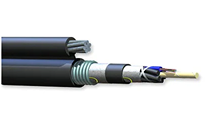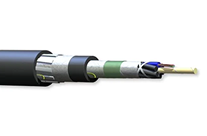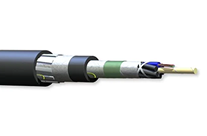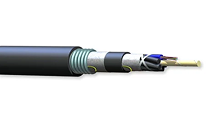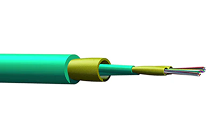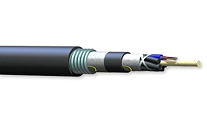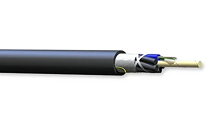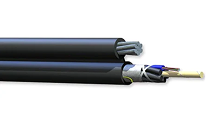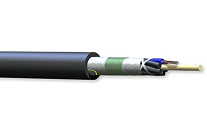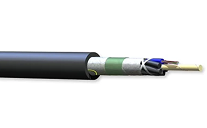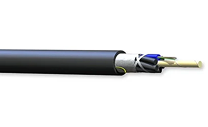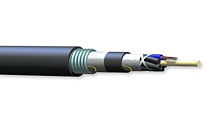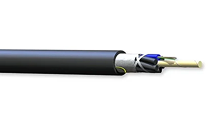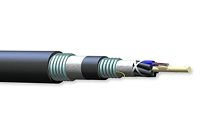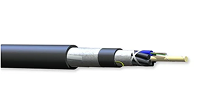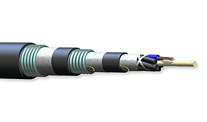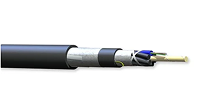Collection: Loose Tube
- Previous page
- Page 2 of 2
About the loose tube
A "loose tube" is a type of fiber optic cable construction designed for harsh outdoor and long-distance applications, such as telecommunications backbones and underground installations. The design protects the delicate optical fibers from environmental stresses like moisture and temperature fluctuations by enclosing them loosely within protective tubes.
Key characteristics and construction
- Loose fiber placement: Unlike tight-buffered cables where the fiber is coated directly, loose tube cables house multiple optical fibers in semi-rigid "buffer tubes" that are not tightly bonded to the fibers. This allows the fibers to move freely within the tube.
- Environmental resilience: The design protects the cable from external forces and environmental factors.
- Temperature: The loose structure prevents mechanical stress on the fibers from the expansion and contraction of the cable materials in fluctuating temperatures.
- Moisture: The buffer tubes are often filled with a water-resistant gel or use dry, water-blocking materials to prevent water ingress, making them suitable for wet or humid conditions and underground installations.
- High fiber count: Loose tube cables can contain a large number of individual fibers, sometimes up to 432, making them ideal for high-capacity networks like data centers and network backbones.
- Tensile strength: These cables often include strength members, such as aramid yarns or fiberglass rods, to enhance their resistance to tension during installation.
Typical applications
- Long-haul telecommunications: The robustness and capacity of loose tube cables make them the standard for long-distance, high-bandwidth communication lines.
- Outdoor installations: They are designed for aerial, direct-buried, and underwater deployments where they are exposed to weather and physical stress.
- Campus backbones and duct installations: Loose tube cables are used to connect buildings in campus networks or to run through buried conduits and ducts to protect fibers from damage.
- Harsh industrial environments: Armored loose tube options are available for industrial settings, such as manufacturing plants or mining operations, to withstand physical damage and chemical exposure.
Disadvantages and considerations
- Termination complexity: The gel-filled versions require a messy and time-consuming cleaning process before splicing or terminating the fibers, which is often difficult and costly for smaller indoor jobs.
- Installation requirements: Because they are not typically compatible with indoor fire codes, loose tube cables must be terminated at the point of entry to a building or be replaced with tight-buffered cables for indoor routing.
BestSellers

- Sale price
- $1.50
- Regular price
- $1.50

- Sale price
- $1.34
- Regular price
- $1.34

- Sale price
- $1.45
- Regular price
- $1.45

- Sale price
- $0.67
- Regular price
- $0.67

- Sale price
- $1.69
- Regular price
- $1.69

- Sale price
- $0.57
- Regular price
- $0.57

- Sale price
- $0.54
- Regular price
- $0.54

- Sale price
- $0.92
- Regular price
- $0.92

- Sale price
- $1.09
- Regular price
- $1.09

- Sale price
- $1.19
- Regular price
- $1.19

- Sale price
- $372.50
- Regular price
- $372.50

- Sale price
- $90.00
- Regular price
- $90.00

- Sale price
- $57.50
- Regular price
- $57.50

- Sale price
- $62.50
- Regular price
- $62.50

- Sale price
- $85.00
- Regular price
- $85.00

- Sale price
- $120.00
- Regular price
- $120.00

- Sale price
- $265.00
- Regular price
- $265.00

- Sale price
- $172.50
- Regular price
- $172.50

- Sale price
- $172.50
- Regular price
- $172.50

- Sale price
- $115.00
- Regular price
- $115.00

- Sale price
- $180.00
- Regular price
- $180.00

- Sale price
- $745.00
- Regular price
- $745.00

- Sale price
- $45.00
- Regular price
- $45.00

- Sale price
- $0.60
- Regular price
- $0.60

- Sale price
- $305.00
- Regular price
- $305.00

- Sale price
- $2.19
- Regular price
- $2.19

- Sale price
- $247.50
- Regular price
- $247.50

- Sale price
- $1.46
- Regular price
- $1.46

- Sale price
- $340.00
- Regular price
- $340.00

- Sale price
- $325.00
- Regular price
- $325.00

- Sale price
- $170.00
- Regular price
- $170.00

- Sale price
- $670.00
- Regular price
- $670.00

- Sale price
- $505.00
- Regular price
- $505.00

- Sale price
- $360.00
- Regular price
- $360.00

- Sale price
- $1,620.00
- Regular price
- $1,620.00

- Sale price
- $965.00
- Regular price
- $965.00

- Sale price
- $327.50
- Regular price
- $327.50

- Sale price
- $122.50
- Regular price
- $122.50

- Sale price
- $1,480.00
- Regular price
- $1,480.00

- Sale price
- $407.50
- Regular price
- $407.50

- Sale price
- $477.50
- Regular price
- $477.50

- Sale price
- $655.00
- Regular price
- $655.00

- Sale price
- $350.00
- Regular price
- $350.00

- Sale price
- $0.49
- Regular price
- $0.49

- Sale price
- $812.50
- Regular price
- $812.50

- Sale price
- $1,320.00
- Regular price
- $1,320.00

- Sale price
- $1,167.50
- Regular price
- $1,167.50


